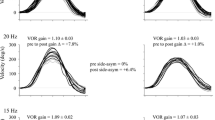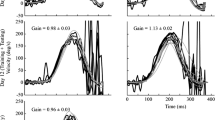Abstract
The gain of the vestibulo-ocular reflex (VOR) normally depends on the distance between the subject and the visual target, but it remains uncertain whether vergence angle can be linked to changes in VOR gain through a process of context-dependent adaptation. In this study, we examined this question with an adaptation paradigm that modified the normal relationship between vergence angle and retinal image motion. Subjects were rotated sinusoidally while they viewed an optokinetic (OKN) stimulus through either diverging or converging prisms. In three subjects the diverging prisms were worn while the OKN stimulus moved out of phase with the head, and the converging prisms were worn when the OKN stimulus moved in-phase with the head. The relationship between the vergence angle and OKN stimulus was reversed in the fourth subject. After 2 h of training, the VOR gain at the two vergence angles changed significantly in all of the subjects, evidenced by the two different VOR gains that could be immediately accessed by switching between the diverged and converged conditions. The results demonstrate that subjects can learn to use vergence angle as the contextual cue that retrieves adaptive changes in the angular VOR.




Similar content being viewed by others
References
Angelaki DE, McHenry MQ (1999) Short-latency primate vestibulo-ocular responses during translation. J Neurophysiol 82:1651–1654
Baker JF, Perlmutter SI, Peterson BW, Rude SA, Robinson FR (1987) Simultaneous opposing adaptive changes in cat vestibulo-ocular reflex direction for two body orientations. Exp Brain Res 69:220–224
Baloh RW, Yue Q, Demer JL (1995) The linear vestibulo-ocular reflex in normal subjects and patients with vestibular and cerebellar lesions. J Vestib Res 5:349–361
Broussard DM, Bronte-Stewart HM, Lisberger SG (1992) Expression of motor learning in the response of the primate vestibulo-ocular pathway to electrical stimulation. J Neurophysiol 67:1493–1508
Crane BT, Demer JL (1998) Human vestibulo-ocular reflex initiation: effects of acceleration, target distance, and unilateral deafferentation. J Neurophysiol 80:1151–1166
Crane BT, Demer JL (2000) Effect of adaptation to telescopic spectacles on the initial human horizontal vestibulo-ocular reflex. J Neurophysiol 83:38–49
Crane BT, Tian J-R, Demer JL (2000) Initial vestibulo-ocular reflex during transient angular and linear acceleration in human cerebellar dysfunction. Exp Brain Res 130:486–496
Crane BT, Tian J, Wiest G, Demer JL (2003) Initiation of the human heave linear vestibulo-ocular reflex. Exp Brain Res 148:247–255
Erkelens CJ, Collewijn H (1985) Eye movements and stereopsis during dichoptic viewing of moving random-dot stereograms. Vision Res 25:1689–1700
Gandolfo F, Mussa-Ivaldi FA, Bizzi E (1996) Motor learning by field approximation. Proc Natl Acad Sci USA 30:3843–3846
Gauthier GM, Robinson DA (1975) Adaptation of the human vestibulo-ocular reflex to magnifying lenses. Brain Res 92:331–335
Ghahramani Z, Wolpert DM (1997) Modular decomposition in visuomotor learning. Nature 386:392–395
Held R, Freedman SJ (1963) Plasiticity in human sensorimotor control. Science 142:437–454
Hine T, Thorn F (1987) Compensatory eye movements during active head rotation for near targets: effects of imagination, rapid head oscillation and vergence. Vision Res 27:1639–1657
Kramer PD, Shelhamer M, Zee DS (1998) Short-term vestibulo-ocular adaptation: influence of context. Otolaryngol Head Neck Surg 119:60–64
Lasker DM, Ramat S, Carey JP, Minor LB (2002) Vergence-mediated modulation of the human horizontal angular VOR provides evidence of pathway-specific changes in VOR dynamics. Ann NY Acad Sci 956:324–337
Lewis RF (2003) Context-dependent adaptation of visually guided arm movements and vestibular eye movements: role of the cerebellum. Cerebellum (in press)
Lewis RF, Tamargo RJ (2001) Cerebellar lesions impair context-dependent adaptation of reaching movements in primates. Exp Brain Res 138:263–267
Lisberger SG, Miles FA, Optican LM (1983) Frequency selective adaptation: evidence for channels in the vestibulo-ocular reflex. J Neurosci 3:1234–1244
Lisberger SG, Miles FA, Zee DS (1984) Signals used to compute errors in monkey vestibulo-ocular reflex: possible role of the flocculus. J Neurophysiol 52:1140–1153
Martin TA, Keating JG, Bastian AJ, Thach WT (1996) Throwing while looking through prisms. II. Specificity and storage of multiple gaze-throw calibrations. Brain 119:1199–1211
Paige GD (1989) The influence of target distance on eye movement responses during vertical linear motion. Exp Brain Res 77:585–593
Schwarz U, Miles FA (1991) Ocular responses to translation and their dependence on viewing distance. I. Motion of the observer. J Neurophysiol 66:851–864
Shelhamer M, Robinson DA, Tan HS (1992) Context-specific adaptation of the gain of the vestibulo-ocular reflex in humans. J Vestib Res 2:89–96
Snyder LH, King WM (1992) Effect of viewing distance and location of the axis of head rotation on the monkey's vestibulo-ocular reflex. I. Eye movement responses. J Neurophysiol 67:861–874
Staddon JE, Cerutti DT (2003) Operant conditioning. Ann Rev Psychol 54:115–144
Takagi M, Abe H, Hasegawa S, Usui T, Hasebe H, Miki A, Zee DS (2000) Context-specific adaptation of pursuit initiation in humans. Invest Ophthalmol Vis Sci 41:3763–3769
Telford L, Seidman SH, Paige GD (1997) Dynamics of squirrel monkey linear vestibulo-ocular reflex and interactions with fixation distance. J Neurophysiol 78:1775–1790
Tiliket C, Shelhamer M, Tan HS, Zee DS (1992) Adaptation of the vestibulo-ocular reflex with the head in different orientations and positions relative to the axis of body rotation. J Vestib Res 3:181–195
Yakushin SB, Raphan T, Cohen B (2000) Context-specific adaptation of the vertical vestibulo-ocular reflex with regard to gravity. J Neurophysiol 84:3067–3071
Acknowledgements
We thank D. Roberts and A. Lasker. This work was funded in part by grants from NASA (NAG 2-1520, RFL), NIH (EY01849, DSZ), and by NASA through cooperative agreement NCC9-58 with NSBRI.
Author information
Authors and Affiliations
Corresponding author
Rights and permissions
About this article
Cite this article
Lewis, R.F., Clendaniel, R.A. & Zee, D.S. Vergence-dependent adaptation of the vestibulo-ocular reflex. Exp Brain Res 152, 335–340 (2003). https://doi.org/10.1007/s00221-003-1563-9
Received:
Accepted:
Published:
Issue Date:
DOI: https://doi.org/10.1007/s00221-003-1563-9




